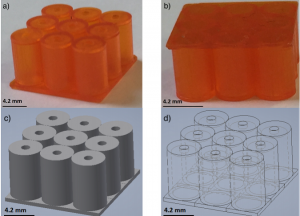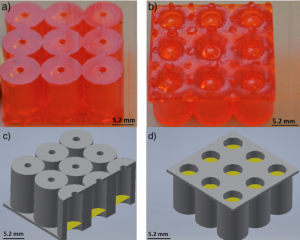We’ve often seen 3D printing used to fabricate headphones and earbuds. But a team of researchers from the Department of Electrical and Electronic Engineering in the University of Strathclyde in Glasgow are taking this idea to the next level with acoustic metamaterials. Metamaterials, which can morph according to their environment, make up a new class of finely-engineered surfaces that can perform nature-defying tasks like 3D printing holograms and shaping sound waves. Acoustic metamaterials have the unique ability to attenuate sound by breaking the mass-density law, due to properties such as negative effective density and bulk modulus – no easy feat when it comes to small devices since thin walls are easily penetrated by acoustic waves.
 The researchers, who are all affiliated in various capacities with the university’s Centre for Ultrasonic Engineering (CUE), recently published a paper, titled “Enhancing the Sound Absorption of Small-Scale 3D Printed Acoustic Metamaterials Based on Helmholtz Resonators,” detailing how their SLA 3D printed acoustic metametarials, based on Helmholtz resonators, can be used for small-scale sound absorption applications.
The researchers, who are all affiliated in various capacities with the university’s Centre for Ultrasonic Engineering (CUE), recently published a paper, titled “Enhancing the Sound Absorption of Small-Scale 3D Printed Acoustic Metamaterials Based on Helmholtz Resonators,” detailing how their SLA 3D printed acoustic metametarials, based on Helmholtz resonators, can be used for small-scale sound absorption applications.
The abstract reads, “The directional response due to the position of the acoustic source on the sound attenuation provided by the metamaterial is investigated by controlling the location of a loudspeaker with a robot arm. To enhance and broaden the absorption bands, structural modifications are added such that overtones are tuned to selected frequencies, and membranes are included at the base of the resonators. This design is made possible by innovative 3D printing techniques based on stereolithography and on the use of specific UV-curable resins. These results show that these designs could be used for sound control in small-scale electroacoustic devices and sensors.”
To cut a material’s sound transmission by half, you have to double its acoustic frequency, density, or thickness. When an acoustic metamaterial has negative parameters, stop bands will form where the sound is deeply attenuated at certain frequencies.
“Acoustic metamaterials can break the mass-density law by exploiting the stop bands formed in the proximity of the resonance frequencies of their unit cells,” the researchers explain. “These material structures are often based on Helmholtz resonators and membranes. The frequency band that is attenuated by using these kind of unit cells is nevertheless narrow, hence solutions such as coupling of multiple resonances and leveraging the losses of the materials are generally used to make the attenuation broadband.”
The team’s paper presents a basic design of these small-scale, sub-wavelength 3D printed acoustic metamaterials, which use Helmholtz resonators arrays to generate stop bands where sound attenuation increases with the number of unit cells. A loudspeaker, guided by a KUKA robot arm through a quarter-hemisphere trajectory, illustrated that an absorption band forms “for every angle of incidence of the impinging sound wave.” A reference microphone was used to measure sound transmission in the air, while the transmission above the sample was measured by a second microphone.
The paper also explains two methods of enhancing the stop band, the first of which requires the resonators’ overtones to be tuned more closely to the fundamental frequency; this causes the band to grow wider. The second method involves printing membranes at the resonators’ base.
“In this work a novel fabrication technique is used, where thin membranes are fabricated inside Helmholtz resonators, the two units consisting of different materials,” the researchers wrote. “The presented manufacturing technique could result in rapid prototyping of metamaterials and contribute to the advancement of this field into the industrial environment. Simple physical models of the presented metamaterials are included in each section, nevertheless this work is mostly based on experimental results and aims at developing metamaterials that could be included in real devices. Potential applications of this work include noise cancellation for devices such as headphones, hearing aids and other sensors.”
Work is continuing to advance acoustic metamaterials in applications like acoustic cloaking, sound focusing and waveguiding, and imaging and computation, but the results are not often integrated into functional devices. But if studies like this one by the University of Strathclyde researchers can be validated, we could be looking at vastly improved headphones in the near future.
Co-authors of the paper are IEEE Student Member Cecilia Casarini, Benjamin Tiller, Carmelo Mineo, Charles N. MacLeod, IEEE Senior Member Professor James F. C. Windmill, and Joseph C. Jackson.
Discuss this research and other 3D printing topics at 3DPrintBoard.com or share your thoughts below.





23 Replies to “Could Your Next Headphones Use 3D Printed Metamaterials?”
Comments are closed.